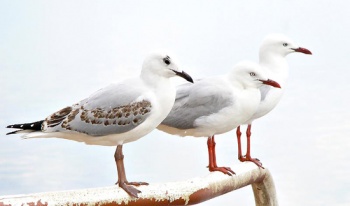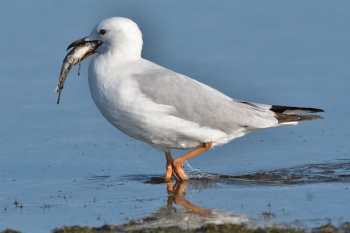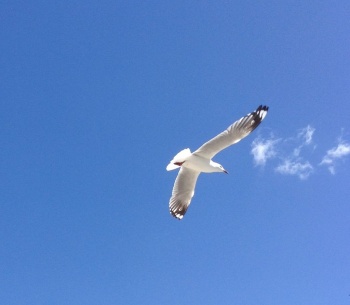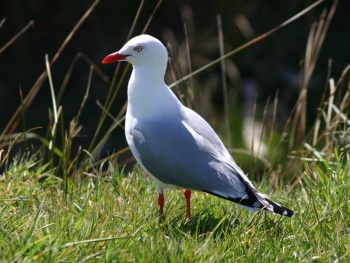(→External Links: GSearch expanded) |
|||
| (16 intermediate revisions by 5 users not shown) | |||
| Line 1: | Line 1: | ||
| − | [[Image: | + | [[Image:Silver Gull, Swanport.jpg|thumb|500px|right|Adult Silver Gull ''C. n. novaehollandiae''<br />Photo © by {{user|peterday|Peter Day}}<br />Swanport Wetlands, Murray Bridge, Adelaide, South [[Australia]], 2 April 2016.]] |
;[[: Category:Chroicocephalus|Chroicocephalus]] novaehollandiae | ;[[: Category:Chroicocephalus|Chroicocephalus]] novaehollandiae | ||
| − | ''Larus novaehollandiae'' | + | ''Larus novaehollandiae''<br /> |
| + | '''Includes Red-billed Gull''' | ||
==Identification== | ==Identification== | ||
| − | + | [[Image:Red-billed Gull.jpg|thumb|350px|right|Adult Red-billed Gull ''C. n. scopulinus''<br />Photo © by {{user|Janha|Janha}}<br />Invercargill, [[New Zealand]], 12 October 2004.]] | |
| − | + | 38-43 cm (15-17 in) | |
| + | *White head, tail and underparts | ||
| + | *Pale grey back and wings | ||
| + | ** Wings black-tipped with white 'mirrors' | ||
| + | *Reddish, legs and eye-ring | ||
| + | *Reddish-orange bill | ||
| + | *White iris | ||
| + | '''Young Birds''': lack the red eye-ring, have a black bill which turns red as they mature. | ||
| + | ====Similar species==== | ||
| + | None within its Australian range, but in [[New Zealand]], care is needed to distinguish the rare [[Black-billed Gull]], which shares the white iris and unmarked white head, but has a slenderer black bill, slightly less black on the primaries, and in summer, also darker legs. Within the genus ''Chroicocephalus'', [[Slender-billed Gull]] also shares the white iris and unmarked white head, but does not occur anywhere nearby. | ||
| + | |||
==Distribution== | ==Distribution== | ||
| − | |||
[[Australia]], [[New Zealand]] and surrounding islands. | [[Australia]], [[New Zealand]] and surrounding islands. | ||
| + | |||
==Taxonomy== | ==Taxonomy== | ||
| − | Three subspecies | + | [[Image:Silver_Gulls.jpg|thumb|350px|right|Immature ''C. n. novaehollandiae'' (front) & two adults.<br />Photo © by {{user|Neil|Neil Fifer}}<br /> Sydney, [[New South Wales]], [[Australia]], 3 December 2004]] |
| − | * ''C. n. forsteri'' | + | As with other species of ''Chroicocephalus'', Silver Gull was formerly placed in the genus ''[[:Category:Larus|Larus]]''. |
| − | * ''C. n. novaehollandiae'' in | + | ====Subspecies==== |
| − | * ''C. n. scopulinus'' in [[New Zealand]], Chatham, Auckland and adjacent islands - | + | Three subspecies recognised, split into two species by Clements<sup>[[#References|1]]</sup> and formerly by IOC<sup>[[#References|2]]</sup>, but not more recently by IOC<sup>[[#References|3]]</sup> nor by Christidis ''et al''.<sup>[[#References|4]]</sup> |
| − | Some authorities | + | * ''C. n. forsteri'' now restricted to [[New Caledonia]], and the Loyalty Islands: Distinctly different wing pattern. Formerly considered to reach Northern Australia<sup>[[#References|8]]</sup>. |
| − | + | * ''C. n. novaehollandiae'' in [[Australia]] and [[Tasmania]]: Longer, less arched bill. | |
| + | * ''C. n. scopulinus'' ('''Red-billed Gull'''; syn. ''C. scopulinus'') in [[New Zealand]], Chatham, Auckland and adjacent islands: Shorter, stubbier, more arched bill and a more squared pattern of white in its wing-tips when seen in flight. | ||
| + | |||
| + | Some authorities also recognise ''C. n. gunni'' in Tasmania, but it intergrades clinally with ''C. n. novaehollandiae''<sup>[[#References|5]]</sup>. | ||
| + | |||
==Habitat== | ==Habitat== | ||
| − | Near water. | + | [[Image:Silver Gull 00000001 01.jpg|thumb|350px|right|Subadult ''C. n. novaehollandiae''<br />Photo © by {{user|Ken+Doy|Ken Doy}}<br />Wellington Point, Brisbane, [[Queensland]], [[Australia]], 11 September 2017]] |
| + | Near water, both coastal and inland wetlands. Sandy and rocky shores, parks, beaches and rubbish dumps. | ||
| + | |||
==Behaviour== | ==Behaviour== | ||
| − | + | ====Diet==== | |
| + | They have a very varied diet, consisting of crustaceans, squid, insects, small fish, frogs and birds. They also scavenge from rubbish dumps. | ||
| + | ====Breeding==== | ||
| + | They nest in large colonies on offshore islands. Both adults share nest-building, incubation and feeding duties. The clutch consists of 3 eggs which are laid in a shallow nest scrape, lined with vegetation. There may be two broods raised in a year. | ||
| + | ====Vocalisation==== | ||
| + | [[Image:Image69.jpeg|thumb|350px|right|Adult ''C. n. novaehollandiae''<br />Photo © by {{user|Kay+Simpson|Kay Simpson}}<br />The Spit Gold Coast, [[Queensland]], [[Australia]], 22 September 2015]] | ||
| + | '''Call:''' a high pitched, raucous ''scrark''. | ||
| + | ==References== | ||
| + | #{{Ref-Clements6thAug17}}#{{Ref-GillDonsker10}}#{{Ref-GillDonsker18V8.2}}#{{Ref-HM04.1}}#{{Ref-HBWVol3}}#Burger, J. & Gochfeld, M. (2017). Red-billed Gull (''Larus scopulinus''). In: del Hoyo, J., Elliott, A., Sargatal, J., Christie, D.A. & de Juana, E. (eds.). Handbook of the Birds of the World Alive. Lynx Edicions, Barcelona. (retrieved from http://www.hbw.com/node/53992 on 11 February 2017). | ||
| + | #BF Member observations | ||
| + | #Higgins, P.J. & Davies, S.J.J.F. (editors) 1996. Handbook of Australian , New Zealand & Antarctic Birds. Volume 3, Snipe to pigeons. Melbourne, Oxford University Press. [Vol. 2, pages 648-649] Vol. 3, pages 384-385, 468-470, 517-545; plates 32 & 34. | ||
| + | #Mills, J.A. 2013. Red-billed gull. In Miskelly, C.M. (ed.) New Zealand Birds Online. http://www.nzbirdsonline.org.nz | ||
| + | {{ref}} | ||
| + | |||
| + | ==External Links== | ||
| + | {{GSearch|"Chroicocephalus novaehollandiae" {{!}} "Larus novaehollandiae" {{!}} "Silver Gull" {{!}} "Red-billed Gull"}} | ||
| + | {{GS-checked}}1 | ||
| + | <br /> | ||
| + | <br /> | ||
| + | |||
| − | |||
| − | |||
| − | |||
| − | |||
| − | |||
[[Category:Birds]] [[Category:Chroicocephalus]] | [[Category:Birds]] [[Category:Chroicocephalus]] | ||
Latest revision as of 11:42, 25 January 2023
- Chroicocephalus novaehollandiae
Larus novaehollandiae
Includes Red-billed Gull
Identification
38-43 cm (15-17 in)
- White head, tail and underparts
- Pale grey back and wings
- Wings black-tipped with white 'mirrors'
- Reddish, legs and eye-ring
- Reddish-orange bill
- White iris
Young Birds: lack the red eye-ring, have a black bill which turns red as they mature.
Similar species
None within its Australian range, but in New Zealand, care is needed to distinguish the rare Black-billed Gull, which shares the white iris and unmarked white head, but has a slenderer black bill, slightly less black on the primaries, and in summer, also darker legs. Within the genus Chroicocephalus, Slender-billed Gull also shares the white iris and unmarked white head, but does not occur anywhere nearby.
Distribution
Australia, New Zealand and surrounding islands.
Taxonomy

Photo © by Neil Fifer
Sydney, New South Wales, Australia, 3 December 2004
As with other species of Chroicocephalus, Silver Gull was formerly placed in the genus Larus.
Subspecies
Three subspecies recognised, split into two species by Clements1 and formerly by IOC2, but not more recently by IOC3 nor by Christidis et al.4
- C. n. forsteri now restricted to New Caledonia, and the Loyalty Islands: Distinctly different wing pattern. Formerly considered to reach Northern Australia8.
- C. n. novaehollandiae in Australia and Tasmania: Longer, less arched bill.
- C. n. scopulinus (Red-billed Gull; syn. C. scopulinus) in New Zealand, Chatham, Auckland and adjacent islands: Shorter, stubbier, more arched bill and a more squared pattern of white in its wing-tips when seen in flight.
Some authorities also recognise C. n. gunni in Tasmania, but it intergrades clinally with C. n. novaehollandiae5.
Habitat

Photo © by Ken Doy
Wellington Point, Brisbane, Queensland, Australia, 11 September 2017
Near water, both coastal and inland wetlands. Sandy and rocky shores, parks, beaches and rubbish dumps.
Behaviour
Diet
They have a very varied diet, consisting of crustaceans, squid, insects, small fish, frogs and birds. They also scavenge from rubbish dumps.
Breeding
They nest in large colonies on offshore islands. Both adults share nest-building, incubation and feeding duties. The clutch consists of 3 eggs which are laid in a shallow nest scrape, lined with vegetation. There may be two broods raised in a year.
Vocalisation

Photo © by Kay Simpson
The Spit Gold Coast, Queensland, Australia, 22 September 2015
Call: a high pitched, raucous scrark.
References
- Clements, J. F., T. S. Schulenberg, M. J. Iliff, D. Roberson, T. A. Fredericks, B. L. Sullivan, and C. L. Wood. 2017. The eBird/Clements checklist of birds of the world: v2017, with updates to August 2017. Downloaded from http://www.birds.cornell.edu/clementschecklist/download/
- Gill, F and D Donsker (Eds). 2010. IOC World Bird Names (version 2.7). Available at http://www.worldbirdnames.org/.
- Gill, F & D Donsker (Eds). 2018. IOC World Bird List (v8.2). doi : 10.14344/IOC.ML.8.2. Available at http://www.worldbirdnames.org/
- Christidis et al. 2018. The Howard and Moore Complete Checklist of the Birds of the World, version 4.1 (Downloadable checklist). Accessed from https://www.howardandmoore.org.
- Del Hoyo, J, A Elliot, and J Sargatal, eds. 1996. Handbook of the Birds of the World. Volume 3: Hoatzin to Auks. Barcelona: Lynx Edicions. ISBN 978-8487334207
- Burger, J. & Gochfeld, M. (2017). Red-billed Gull (Larus scopulinus). In: del Hoyo, J., Elliott, A., Sargatal, J., Christie, D.A. & de Juana, E. (eds.). Handbook of the Birds of the World Alive. Lynx Edicions, Barcelona. (retrieved from http://www.hbw.com/node/53992 on 11 February 2017).
- BF Member observations
- Higgins, P.J. & Davies, S.J.J.F. (editors) 1996. Handbook of Australian , New Zealand & Antarctic Birds. Volume 3, Snipe to pigeons. Melbourne, Oxford University Press. [Vol. 2, pages 648-649] Vol. 3, pages 384-385, 468-470, 517-545; plates 32 & 34.
- Mills, J.A. 2013. Red-billed gull. In Miskelly, C.M. (ed.) New Zealand Birds Online. http://www.nzbirdsonline.org.nz
Recommended Citation
- BirdForum Opus contributors. (2024) Silver Gull. In: BirdForum, the forum for wild birds and birding. Retrieved 16 May 2024 from https://www.birdforum.net/opus/Silver_Gull
External Links
GSearch checked for 2020 platform.1





